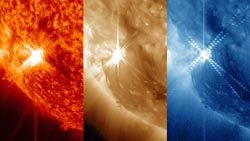Sun Emits a Mid-level Flare

By observing the sun in a number of different wavelengths, NASA's telescopes can tease out different aspects of events on the sun. These three images of a solar flare on Nov. 13, 2012, captured by NASA's Solar Dynamics Observatory (SDO), show from left to right: light in the 304 Ångstrom wavelength, which shows light from the region of the sun's atmosphere where flares originate; light from the sun in the 193 Ångstrom wavelength, which shows the hotter material of a solar flare; and light in 335 Ångstroms, which highlights light from active regions in the corona. Credit: NASA/SDO/Goddard Space Flight Center <br>
Solar flares are powerful bursts of radiation. Harmful radiation from a flare cannot pass through Earth's atmosphere to physically affect humans on the ground, however — when intense enough — they can disturb the atmosphere in the layer where Global Positioning System (GPS) and communications signals travel. This disrupts the radio signals for as long as the flare is ongoing, anywhere from minutes to hours.
This flare is classified as an M6 flare. M-class flares are the weakest flares that can still cause some space weather effects near Earth. They can cause brief radio blackouts at the poles. This M-class flare caused a radio blackout categorized according to the National Oceanic and Atmospheric Association's Space Weather Scales as R2 — or “moderate” — on a scale of R1 to R5. It has since subsided.
Increased numbers of flares are quite common at the moment, since the sun's normal 11-year activity cycle is ramping up toward solar maximum, which is expected in 2013. Humans have tracked this solar cycle continuously since it was discovered in 1843, and it is normal for there to be many flares a day during the sun's peak activity.
The flare was not associated with a coronal mass ejection (CME), another solar phenomenon that can send solar particles into space and can reach Earth one to three days later.
Updates will be provided as needed.
What is a solar flare?
For answers to this and other space weather questions, please visit the Spaceweather Frequently Asked Questions page: http://www.nasa.gov/mission_pages/sunearth/spaceweather/index.html
Karen C. Fox
NASA's Goddard Space Flight Center, Greenbelt, Md.
Media Contact
All latest news from the category: Physics and Astronomy
This area deals with the fundamental laws and building blocks of nature and how they interact, the properties and the behavior of matter, and research into space and time and their structures.
innovations-report provides in-depth reports and articles on subjects such as astrophysics, laser technologies, nuclear, quantum, particle and solid-state physics, nanotechnologies, planetary research and findings (Mars, Venus) and developments related to the Hubble Telescope.
Newest articles

Microscopic basis of a new form of quantum magnetism
Not all magnets are the same. When we think of magnetism, we often think of magnets that stick to a refrigerator’s door. For these types of magnets, the electronic interactions…

An epigenome editing toolkit to dissect the mechanisms of gene regulation
A study from the Hackett group at EMBL Rome led to the development of a powerful epigenetic editing technology, which unlocks the ability to precisely program chromatin modifications. Understanding how…

NASA selects UF mission to better track the Earth’s water and ice
NASA has selected a team of University of Florida aerospace engineers to pursue a groundbreaking $12 million mission aimed at improving the way we track changes in Earth’s structures, such…





















